Find out more about the
gentle but effective treatment options
Physician Locator
Please use the form below to find a physician near you.
Any medical questions should be discussed directly with your physician.
Find out more about the gentle but particularly effective treatment options with our technologies. Our doctor finder will help you to find a suitable medical practice quickly and easily near you for your desired treatment.
Many patients want to look younger. With age, the quality and elasticity of the skin deteriorate, creating fine lines and wrinkles. The loss of volume on the face also contributes to signs of aging. Skin aging is determined by the genetic makeup, but other factors such as smoking, regular or excessive sunbathing or poor nutrition also accelerate skin aging. Skin tightening is a commonly used method to reduce wrinkles or fine lines and to treat sagging skin.
Therapy options
There are many different methods of skin tightening available. With all of these methods, the skin is stimulated to renew and rejuvenate, and there is skin contraction and tightening. The best results are achieved with a surgical facelift, but many patients want to avoid the risks and inconveniences associated with surgery. Non-surgical treatment options: dermabrasion and chemical peeling, but energy-based methods using radio frequency (RF), microneedle technology or lasers are more effective.

Treatments with the unique Microneedling technology stimulate collagen production in your skin. Means Highly focused radio frequency can achieve impressive results.
Microneedling uses your body’s own reaction to tighten the skin. The energy is fed directly into your dermis via gold-plated microneedles. The supply of energy stimulates the natural formation of collagen and Elastin. This unique and innovative technology protects the upper skin layer and at the same time enables the treatment of all skin types, including tanned skin.
What downtime do I have to expect with treatments with micro-needle radio frequency systems?
The precise intra-dermal energy release of the Laser eliminates the thermal damage to the skin surface and
provides faster healing with minimal downtime (1-2 days). This reduces the risk of PIH (post-inflammatory hyperpigmentation) for all skin types.
What is the comfort of treatment?
The comfort of treatment depends on the respective procedure, device and personal tolerance. Lutronic devices have been developed for maximum comfort.
How long is healing and downtime?
Some laser or RF procedures involve little or no downtime. With more intensive procedures, longer downtimes of 5 to 7 days occur.
The healing times can be quite different and depend on different factors, such as B. Treatment, location and size of the treated area, device and physical characteristics.
It is particularly interesting with laser or RF procedures that an improvement in the condition is not only visible immediately after the treatment, but your body continuously forms new collagen tissue, so that improvements can still be seen even after several months.
Treatment is every 4 to 6 weeks. How often depends on the skin condition and can be determined more precisely after the first session, when the skin is ready to regenerate. Most patients achieve the best results after 3 to 5 treatments.
An improvement in the condition is not only visible immediately after the treatment, but your body continuously forms new collagen tissue, so that improvements can still be seen even after several months.
What is Skin Resurfacing?
Skin resurfacing is the treatment, or removal of some or all of the surface layers of skin as a therapeutic alternative to the surgical face lift. While still the gold standard, surgical lifting is a major procedure with inherent risks, and many patients wish to avoid the procedure altogether. Patients undergoing skin resurfacing treatments may also wish to stave off the need for a future face lift or simply age more gracefully. Although most often performed on the face, skin resurfacing may be performed on the body.
Different procedures, alone or in conjunction, vary in invasiveness and have a range of benefits beyond reduction of laxity including improvements in fine lines and wrinkles, firmness, texture, pore size, the appearance of photodamage (such as vascular and pigmented lesions), and a general healthy glow.
How does it work?
Energy-based skin resurfacing generally describes the delivery of therapeutic energy to the epidermis and / or dermis for thermal coagulation of tissue and stimulation of neocollagenesis, as well as the vaporization or ablation of surface tissue. Adequate skin cooling maximizes patient comfort and allows practitioners to deliver more energy safely; modulation of treatment parameters allows users to customize treatment based on the condition and skin type of the individual patient, to maximize results as well as manage patient comfort and the potential for side effects. Treatment of darker skin with laser or light-based modalities can be problematic due to the increased potential for burning or post-inflammatory hyperpigmentation (PIH). In most cases several treatment sessions are required to fully realize outcomes.
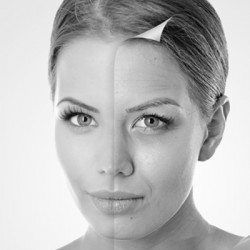
Is the procedure painful?
The sensation of pain or other complaints is of a different intensity for every person. Your doctor will take the appropriate measures to keep your symptoms as low as possible during treatment. A local anesthetic is used and, in some cases, oral medication for pain relief is also prescribed. If necessary, the entire area to be treated can be anesthetized.
What does the skin look like immediately after the treatment?
After the treatment, you can expect swelling and redness. If the treatment was very intense, the treated area is red for a long time. In most cases, the redness subsides within three weeks. During this period – with the exception of the first few days after treatment – you can apply makeup to mask the redness. Normal activities can usually be resumed within 5 to 7 days.
Do I need multiple treatments?
Multiple treatments may be required for deep scars and / or wrinkles. The number of treatments also depends on your own expectations. Maybe after a few months you may want to make another improvement. Your doctor will assess how many treatments are necessary at the first appointment.
When are results recognizable?
After a few days, the skin looks smoother and the skin tone looks more even. Your skin will improve over a period of six to nine months as old collagen is replaced by newly formed collagen.
How long do the treatment results last?
The aging process of your skin naturally progresses. To minimize progressive skin aging, you can get tips on preventive measures from your doctor. This can be using an effective sunscreen or good makeup, etc. You can get used to wearing a sun hat or doing sports in the early morning or late afternoon to avoid the sun-intensive times of the day. These practical tips for a changed lifestyle are designed to help keep your skin renewed and healthier.
Acne vulgaris, commonly known as acne, is one of the most common skin conditions, especially in adolescence. Acne occurs in many different forms, such as black or white blackheads, pimples and pustules, or scaly red areas. These can be related to Size, shape, number and concentration vary. Acne can break out with different degrees of severity and duration. Acne can be accompanied by scars. Often hormones are responsible for acne in some way, for example in adolescents. However, stress, certain bacteria and Food matters, genetic factors are at work, acne is considered unaesthetic, and acne and acne scars can affect a patient’s quality of life.
Therapy options
Acne is often treated with over-the-counter topical wash solutions, prescription topical medications, and dermabrasion or chemical peels. Other treatment options include low-level light therapy (LLLT), therapy with intensely pulsed light (IPL), photodynamic therapy (combination treatment with light and topical medications to enhance the light effect) or laser peeling and other energy-based devices. The success of the treatment depends on the respective treatment and the patient. Usually several treatments are required for a good result. There is no cure for acne, but it can be curbed and significantly reduced.

A particularly effective procedure against active acne is SpectraPeel from Lutronic. It is a laser peel with the following properties:
– Relieves all forms of acne
– Curbs sebum production
– Shrinks large pores
– Reduces skin redness in inflammatory acne
– Safe use even with inflammatory acne
– No medication required
– Blackheads do not have to be removed
– Reduces recurrence and inflammation of acne
The Laser Peel not only improves uneven pigments, but can also reduce the occurrence of structural irregularities and fine lines. Laser energy works in two ways: first, it gently targets the melanin (pigmentation) in the cells, which breaks it down for your body’s natural removal processes, and secondly, it heats up deep in the dermis, causing the skin to contract and stimulate collagen. The laser energy removes the Spectra lotion, warms the skin and easily removes the top layer of dead skin. The laser energy breaks up pigments, the fragments of which are broken down by your body’s own mechanisms, and warms the skin, causing it to contract and at the same time stimulate the formation of collagen. The result: luminous, refreshed-looking skin, an improved complexion, a smoother skin feel, and a reduction in fine lines and acne scars.
Regular Laser Peel treatments can help maintain clinical results and keep the skin clean. A treatment interval of three months is usually sufficient. Your doctor will give you tips on how to maintain the improved condition of your skin.
The number of treatments depends on the severity of the acne and the selected treatment. Your doctor will explain the different treatment options and recommend a suitable after-treatment for you.
The Laser Peel treatment is extremely effective and offers long-lasting results, but its effects are not permanent, as with normal laser treatments. The clinical results can be obtained through regular treatments and the skin remains clean.
Acne scars are an unpleasant side effect of acne. Many people retain scars after acne. There are treatments that help relieve acne scars.
What are scars?
Scars can have a significant impact on quality of life, which is why many sufferers want treatment to improve their appearance. The scar tissue affects how your skin looks and feels, and can be sensitive, painful, or itchy. Scars can result from injuries after accidents, surgery or illnesses like acne. Scars develop during the natural healing process when the body forms new tissue, the appearance and quality of which differ from the previous skin.
Therapy options
Different scars are treated with different methods. For some scars, the appearance can already be improved by fusing with the surrounding tissue. Other scars require more aggressive treatment with lasers or comparable forms of energy to remove scar tissue and stimulate the body to produce better quality skin. Scars can be treated with chemical peeling or injectable filling material, dermabrasion, microneedle therapy, nonablative laser therapy and ablative laser therapy or fractional radio frequency therapy and microneedling.

Laser scar modeling supports the body’s natural healing mechanism so that the scar tissue is remodeled with healthy tissue.
How does laser scar modeling work?
Extremely small laser energy pulses (smaller than a pin head) are fired into the skin. The energy creates a small, controlled damage. This stimulates your body’s natural process of producing more and healthy tissue and collagen. While it may seem counterproductive to damage damaged tissue again, the healing process triggered drastically improves the appearance, texture and elasticity of the scar tissue.
How does radio frequency microneedling treatment work?
Treatments with the unique GENIUS technology stimulate collagen production in your skin. Means
Highly focused radio frequency can achieve impressive results.
GENIUS uses your body’s own reaction to tighten the skin. The energy is fed directly into your dermis via gold-plated microneedles. The supply of energy stimulates the natural formation of collagen and elastin.
This unique and innovative technology protects the upper skin layer and at the same time enables the treatment of all skin types, including tanned skin.
How long can I expect for treatments with micro-needle radio frequency systems?
The precise energy release of the GENIUS prevents thermal damage to the skin surface and offers faster healing with minimal downtime (1-2 days). This reduces the risk of PIH (post-inflammatory hyperpigmentation) for all skin types.
Some laser or radio frequency processes like GENIUS cause short to no downtime, unlike more intensive processes. The healing times can be quite different and depend on different factors, such as: B. Treatment, location and size of the treatment area, device and physical characteristics. The healing time can be reduced with the Healite II system. Therefore, ask your doctor whether his practice has a healite that can promote your rapid regeneration.
Treatment is every 4 to 6 weeks. How often depends on the skin condition and can be determined more precisely after the first session, when the skin is ready to regenerate. Most patients achieve the best results after 3 to 5 treatments.
An improvement in the condition is not only visible immediately after the treatment, but your body continuously forms new collagen tissue, so that improvements can still be seen even after several months.
Laser hair removal is a non-surgical and non-invasive method of removing unwanted hair. A laser beam penetrates the skin and is attracted to the pigment in the hair. The energy then flows to the growth cells of the hair follicles and inhibits hair growth.
Most people respond well to laser hair removal unless the hair is pigmentless, as is the case with light blonde or white hair. Laser hair removal is only possible if the laser beam can be directed onto pigments. If you have fair skin and dark, thick hair, this treatment is particularly suitable for you. However, Lutronic laser devices for hair removal can treat almost all skin and hair types. With dark skin, the laser settings are adjusted accordingly to protect the skin surface. Your doctor is very familiar with the device and is able to optimally adjust the treatment.
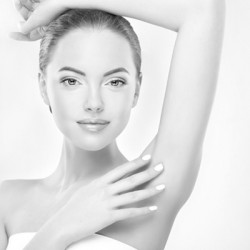
How Does It Work?
The removal or permanent reduction of unwanted hair by laser light depends on the scientific principle of selective photothermolysis. When the correct wavelength of laser light is applied to hair in the treatment area, melanin in the hair absorbs the light, which is converted into heat energy. Buildup of thermal energy causes the destruction of hair follicles as well as associated stem cells and dermal papillae, while the surrounding skin is undamaged. Some follicles will only be damaged or may regrow, so numerous treatments are required to reduce or eliminate unwanted hair effectively for a persistent result.
To successfully remove unwanted hair by laser treatment, one must carefully apply energy so that hair follicles are damaged but nearby skin and tissues are spared. This can be more or less difficult depending on each patient’s individual characteristics such as skin color, hair color, and hair thickness. When treating hair with a laser, one can account for these characteristics by adjusting treatment parameters such as fluence, pulse width, and repetition rate. Many devices are limited in their utility because the different parameters cannot be adjusted independently (if at all). Understandably, treatment of darker skin is more challenging due to the higher concentration of melanin in the skin as a competing chromophore; in those cases treatment may be too painful or cause burning.
Laser energy is applied to hair follicle, heat destroys follicle and prohibits future growth.
Hair growth is a cyclical process. Most patients require at least 3 or more treatments 4 to 8 weeks apart until a satisfactory result is achieved.
If you have light-colored hair, several treatment sessions than usual may be necessary because lighter pigments in the hair do not respond as quickly to laser treatment.
Depending on the size of the area to be treated, the treatment can only take 4 minutes or up to an hour. For example, the treatment of an upper lip or chin takes less than the treatment of an entire back.
At least 10 to 25% reduction in hair growth can be expected with each treatment.
Fine lines and wrinkles
With age, the quality and elasticity of the skin deteriorate, creating fine lines and wrinkles. The loss of volume on the face also contributes to signs of aging. Skin aging is determined by the genetic constitution, but other factors such as smoking, regular or excessive sunbathing or poor nutrition also accelerate the formation of wrinkles. Skin resurfacing is a commonly used method to reduce wrinkles or fine lines and to treat sagging skin. The best results are achieved with a surgical facelift, but many patients want to avoid the risks and inconveniences associated with surgery. More and more patients want to start treatment earlier, before a facelift is even necessary.
Therapy options
There are many different methods for removing fine lines and wrinkles. With all methods, the skin is stimulated to produce new and younger looking skin and there is a skin contraction and tightening. Dermabrasion and chemical peeling are often used, but energy-based methods using radio frequency, laser or light are more effective.
Alternatively, there are also so-called laser peeling treatments.
Laser peeling is recommended for general improvement of the complexion. First, a topical lotion is applied to the face. Then skin cells are stimulated with laser and the exfoliation process is initiated. For optimal results, several treatments (3 on average) should be carried out. This can reduce sebum production and enlarged pores, improve skin tone, soften fine lines and create new collagen.
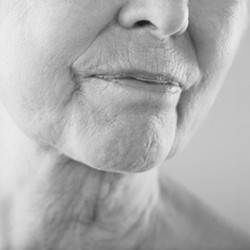
Generally, energy-based treatments apply heat (energy) to the skin to stimulate skin healing and collagen formation. Each laser uses heat (energy) in a specific way to achieve this goal. In some systems, fine holes are made in the skin, while in others, a fine cell layer is removed or the collagen formation is stimulated by the direct application of heat. Still other systems release energy at the tip of microneedles. These treatments can be used as monotherapy or as combination therapy in connection with a facelift.
All methods have advantages. Contact your doctor to find out which method is right for you.
How comfortable is the treatment?
The comfort of treatment depends on the respective procedure, device and personal tolerance. Lutronic devices have been developed for maximum comfort.
What recovery and downtime do I have to expect?
Some laser or radio frequency procedures cause short to no downtime, unlike more intensive procedures. The healing times can be quite different and depend on different factors, such as B. Treatment settings, location and size of the treatment area, device and physical characteristics.
The healing time can be reduced with the Healite II system. Therefore, ask your doctor whether his practice has a healite that can promote your rapid regeneration.
It is particularly interesting with laser or RF procedures that an improvement in the condition is not only visible immediately after the treatment, but that your body continuously forms new collagen tissue, so that improvements can still be seen even after several months.
How does radio frequency microneedling treatment work?
Treatments with the unique GENIUS technology stimulate collagen production in your skin. Means
Highly focused radio frequency can achieve impressive results.
GENIUS uses your body’s own reaction to tighten the skin. The energy is fed directly into your dermis via gold-plated microneedles. The supply of energy stimulates the natural growth of collagen and elastin.
This unique and innovative technology protects the upper skin layer and at the same time enables the treatment of all skin types, including tanned skin.
What downtime do I have to expect with treatments with micro-needle radio frequency systems?
The precise intra-dermal energy release of the GENIUS eliminates the thermal damage to the skin surface and offers faster healing with minimal downtime (1-2 days). This reduces the risk of PIH (post-inflammatory hyperpigmentation) for all skin types.
When are results recognizable? (from the text skin rejuvenation)
After a few days, the skin looks smoother and the skin tone looks more even. Your skin will improve over a period of six to nine months as old collagen is replaced with newly formed collagen.
Deep wrinkles and / or scars may require multiple treatments. The number of treatments also depends on your own expectations. Maybe after a few months you may want to make another improvement. Your doctor will assess how many treatments are necessary at the first appointment.
How long do the treatment results last?
The aging process of your skin naturally also continues after a skin rejuvenation treatment. In order to minimize the progressive skin aging, you can get tips from your doctor for preventive measures. This can be the use of an effective sunscreen or good makeup, etc. You may get used to wearing a sun hat or exercise early in the morning or late afternoon to avoid the sun-intensive times of the day. These practical tips for a changed lifestyle should help you to maintain your new and healthier skin for a long time.
Today there are laser processes that are specially designed for vaginal and vulvo-vaginal use. These treatments stimulate and regenerate the flaccid tissue that has been attacked by birth, disease, surgery or due to natural aging to regenerate collagen and elastin.
Laser treatment for your vaginal health
The laser system offers a non-surgical procedure for vaginal tightening and for the treatment of vaginal atrophy, which can result from birth, aging or surgical interventions. In addition, Action II Petit handpiece rejuvenates the labia for a more youthful look. This gentle treatment method stimulates collagen formation
and tightens the tissue. The treatment of the inner vaginal walls and the labia helps to give a younger appearance and a corresponding feeling.
Wide variety of applications to improve quality of life
• Vulvo-vaginal atrophy
• Dyspareunia
• dysuria
• urinary tract infections
• Vaginal changes after childbirth
• Atrophic vaginitis
• Vaginal relaxation syndrome
• Total vaginal tightening
• Improve sexual satisfaction
• Vaginal dryness
• Atrial & introitus tightening
What speaks for a laser treatment:
• Non-invasive, non-surgical procedure
• bleeding-free – pain-free – scar-free
• Quick and easy to use
• Time-saving, fits easily into your busy schedule
• Pleasant procedure with no downtime
• Safe and reliable thanks to proven technology

The laser procedure is a non-invasive, non-surgical procedure for the treatment of gynecological indications. An Er: YAG laser is used with the Action II Petit handpiece, which treats the vaginal tissue gently. Unlike a CO2 laser, an Er: YAG laser is unlikely to cause tissue necrosis or carbonization; Therefore, it is the first choice for an overall safer and gentler treatment.
The non-surgical approach with the special handpiece through the vaginal canal causes vaginal rejuvenation through the thermal tissue effect, which tightens the anterior vaginal wall and promotes its reconstruction. The laser energy gently focuses on the top layer of the vaginal wall and targets the deeper layers of the skin to stimulate collagen production. Dual Pass technology regenerates both elasticity and function.
Interesting facts about the treatment
Action II Petit is a painless procedure that most women find quick and easy.
You can resume your usual daily routine immediately after the treatment without complaints or medication. There may be a little secretion drainage. Sexual activity is possible again 24 hours after treatment. A session lasts only 5 to 10 minutes. Make an appointment with your doctor outside of your rule.
At your consultation appointment, discuss your treatment goals with your doctor. Depending on this, your doctor will determine the number of applications required. Usually 3-4 sessions are recommended, 14 days apart. You will notice results after the first treatment.
Stress urinary incontinence
In case you experience an unwanted urine delivery, especially at
Coughing, sneezing or laughing, BellaV may be the solution for you
be. The treatment promotes collagen remodeling and the synthesis of new collagen fibers in the area of the anterior vaginal wall
and significantly strengthens the bladder.
Vaginal tightening
The gentlest method for ablation and collagen building thanks to unique dual pass technology: tightening the vaginal canal results in a younger and healthier state of the vagina.
Histological modification of the vaginal wall
The epidermal mucosal component becomes wider, denser and
cell-rich with less stored keratin. The Lamina Propria shows a significantly denser texture of the connective tissue. These processes result in a tightening and firming of the vaginal wall.
Freckles, birthmarks and other forms of benign pigment spots is influenced by a variety of environmental factors such as sun exposure, genetic predisposition and the natural aging process of the skin. Their size, shape and number are completely individual.
Type 1: freckles
Freckles are pigmented areas of skin on the face or body that are caused by the exposure of sunlight to the skin. Many people want freckles to be removed or at least mitigated. Chemical peels and dermabrasion can be used for treatment. However, light and laser-based therapies are most commonly used and are the most effective.
Type 2: birthmarks
Birthmarks often appear in the form of colored, unsightly areas of skin. Many people want these to be removed or at least mitigated. Birthmarks differ in size and shape and can be pigmented or vascular in origin.
Light and laser based therapies are the most commonly used and effective treatments for birthmarks. However, pigmented birthmarks can also be treated well with chemical peeling and dermabrasion.
Type 3: age spots and sun damage
Age spots and sun damage are pigment spots that are darker than the surrounding skin. They occur in the skin areas that are most frequently exposed to the sun, such as. B. face, neck, cleavage and hands. These pigment spots differ in size, shape and number and can develop into skin cancer. Your skin can also be affected by sun damage that is not visible to the naked eye.
Many over-the-counter cosmetic products for treating age spots are available on the market. However, these are often expensive and not very effective. There are several treatment options available to your doctor, such as: For example: chemical peeling and dermabrasion but also light and laser-based therapies. The best results are often achieved with laser and energy-based solutions depending on age, skin type and other factors.
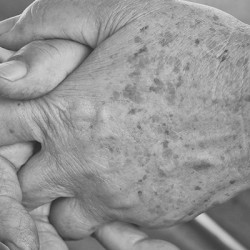
How do laser treatments work to remove pigment spots?
The laser energy is directed onto the pigments (or, for birthmarks, also onto the vascular tissue) and breaks them up. The dead skin cells are then removed by the body’s natural processes. This type of treatment is associated with little damage to the skin and tissue in the surrounding skin region. The degree of difficulty of this treatment depends on factors such as the skin color of the patient and the size, type and number of pigment spots. Treating people with darker skin can be more difficult, but an expert can achieve good results with the appropriate equipment and careful application. In some cases, multiple treatments are required.
Laser treatment:
The treatment with a thulium laser is extremely effective in removing unwanted pigment spots and gives the skin a refreshed appearance. Laser is ideal for patients who want treatment for hyperpigmentation and skin lightening.
A laser device that combines gentle laser treatment with the introduction of cosmeceuticals. Laser treatment creates tiny wounds in the skin tissue and thus enables the active ingredients to penetrate optimally. These get where they are needed to renew and rejuvenate the skin. Many patients see improvements within a few days. However, your skin will continuously improve and renew itself for weeks.
Some laser systems combines a top class thulium laser with exclusive active substance ampoules. These contain substances of the highest purity – but no preservatives. The Cosmeceuticals series was specially developed for LaseMD laser treatment. The ampoules are only freshly mixed during the laser treatment.
VC AMPOULE (ASCORBIC ACID)
Vitamin C is one of the strongest naturally occurring antioxidants. VC helps with new collagen formation
especially in the case of damage caused by solar radiation.
VA AMPOULE VITAMIN A
Vitamin A, also known as retinol or retinoic acid, turns back time and is used to rejuvenate the skin.
It supports the processes for skin renewal.
TA AMPOULE (TRANEXAMIC ACID)
Tranexamic acid has been used for skin lightening in hyperpigmentation for decades.
RS AMPOULE (RESVERATROL, 95% PURITY)
Resveratrol is better known as tartaric acid. The concentration in an RS ampoule corresponds
almost 500 bottles of red wine. RS protects against skin cancer associated with UV radiation and light aging.
How comfortable is the treatment?
The system was developed with the aim of making the treatment as pleasant as possible for the patient. The time-saving process emits the laser energy in extremely fine micro-beams, thus ensuring that the treatment is well tolerated.
What downtime can I expect?
Treatment with LaseMD causes almost no downtime. The microbeams in combination with the optimized energy levels enable faster recovery so that you can resume your normal daily routine immediately.
But the Lutronic Clarity Laser also offers a safe treatment solution for all skin types to remove unwanted pigment spots. Clarity is a non-invasive treatment solution for the reduction of pigments using laser technology and helps you to achieve a more even complexion and a glowing complexion. The laser energy is aimed specifically at unwanted pigment spots in the upper layers of the skin in order to reduce or remove unsightly spots.
How long is a Clarity treatment session?
The treatment takes about 5-15 minutes. This varies depending on the size of the treatment area.
What happens after the laser treatment?
The treated pigment spots turn darker, which can last up to 10 days after the treatment. Gradually, the dissolved pigments are then naturally broken down by the body. Over the following weeks, you will be able to observe how your complexion brightens up significantly.
How many sessions with LaseMD will I need?
The best results are shown after a course of five treatments. Your doctor will individually recommend what is best for your skin and discuss the treatment goal with you.
How many sessions are required with the Clarity laser?
Your doctor will draw up a personal treatment plan with you based on the desired treatment results.
The complexion clears up within a few days after the treatment. The dark pigment spots disappear and your complexion is more even and looks refreshed.
How are tattoos removed?
Laser treatments are safer than other methods. They are minimally invasive and are only used on the ink of the tattoos. Lasers – especially Q-switched lasers – represent the modern standard for tattoo removal. Medical laser devices light up tattoos with a light beam or remove the tattoo completely. When the ink particles absorb the laser light, they are broken down into fragments, which are then absorbed and excreted by the body’s immune system. This process usually takes a few weeks. The larger the tattoo, the more sessions are required to break up the ink particles.

Most patients feel the laser beam as a prick caused by a snapping rubber band. Many treatments do not require anesthesia. However, some patients feel more comfortable with local anesthesia. The skin is cooled with air cooling during the treatment. After the treatment, a bandage with an antibacterial ointment is placed on the treated area to minimize infection.
What does my skin look like after the treatment?
Immediately after the treatment, your skin shows a white discoloration. The area around the tattoo is reddish and swollen. This is normal and will go away after a while. The results are visible about 5 weeks after the treatment.
Are there any side effects?
Occasionally the skin turns white. Your normal skin tone will show up within 6 to 12 months after the last treatment session. Since different inks are used for tattoos, a tattoo can only be partially removed after several sessions.
How many treatments are needed?
How many laser sessions are necessary for the removal depends on the size, location, depth and color of the tattoo as well as the choice of laser system (nano or picosecond laser?). The treatments should be carried out at an interval of 4 to 8 weeks so that the body can remove as much of the tattoo pigment as possible in the meantime.
The individual sessions last 10 to 30 minutes. A lightening of the tattoo can be seen after each treatment, as your body removes more and more pigment. Most patients will gradually see how their tattoos disappear over the next few weeks.
The treatments can lead to the complete removal of the tattoo. The result is always dependent on the ink used, the age and how deep the tattoo was engraved. The treatment results also depend on the speed of the body’s own breakdown system.
What does wound healing with LED LLLT mean?
In low-level light therapy with LED light, certain wavelengths of light are used therapeutically to stimulate the body’s own mechanism for cell repair and thus to improve and accelerate wound healing and regeneration of skin and tissue. This procedure can be used as monotherapy or to support healing. Since the light energy is not aggressive, no tissue is damaged.
LED light therapy:
• accelerates wound healing after laser therapy or surgical interventions
• reduces pain, effusion, edema and redness
• offers prophylaxis against scarring
• reduces PIH (post-inflammatory hyperpigmentation)
• improves clinical outcomes
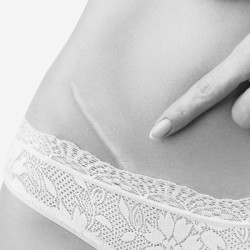
LED phototherapy is non-invasive. The LED lights are positioned over the area to be treated. The light energy penetrates the skin and, depending on the wavelength used, also penetrates the tissue at different depths. The energy acts in the tissue on a cellular level, accelerates the healing process, relieves pain and reduces u. a. the muscle tension.
How long is a treatment session?
The duration of a treatment session depends on the area to be treated and its condition. An average treatment session lasts 10 minutes
Are the treatments painful?
No. Patients feel nothing or only a slight feeling of warmth. Ask your doctor’s office whether she uses Healite for the recovery phase after aesthetic-dermatological energy or laser-based treatments.
The frequency of use depends on the symptoms. 1-2 applications per day would be optimal. In connection with wound treatment, every dressing change should be applied after wound cleaning.
Reduction of local signs of inflammation
Germ reduction
Removal of vital tissue
Detritus
Promotion of granulation formation
Promotion of epithelial formation
Normalization of the wound environment
Pain reduction
Physician Locator
Please use the form below to find
a physician near you.
Any medical questions should be
discussed directly with your physician.
Intelligent Design for Intelligent Care

INNOVATIVe
– Forward Thinking
– Proprietary
– Unique
– Versatile

INTUITIVE
– User Friendly
– Ergonomic
– Easy to Use

DEPENDABLE
– Workhorse
– Durable
– Uptime
– Strong Service

EFFEctive
– Ecacious
– Clinically Backed
– High ROI
– Safe
CONFIDENCE FOR PRACTITIONER — IMPROVED OUTCOMES FOR PATIENTS